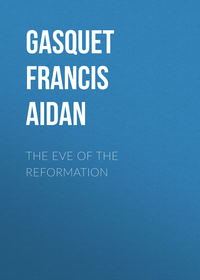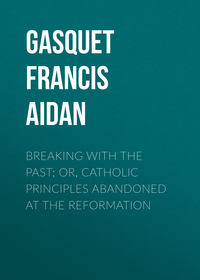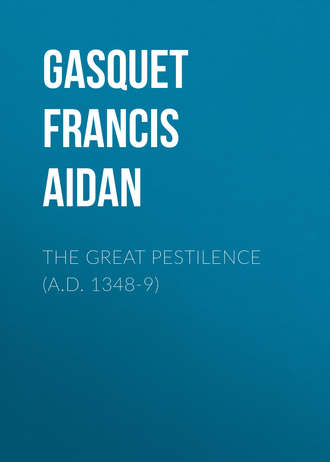 полная версия
полная версияThe Great Pestilence (A.D. 1348-9)
194
Reg. Edyndon, i, fol. 19b.
195
Any doubt about the pestilence to which this letter refers is removed by the dates of the deaths of these last two named. John de Hampton died 4th August, 1356, and William Fyfhide on 18th May, 1361.
196
Winchester Cathedral Archives, Book ii, No. 80. In Book i, No. 120, is an "Exemplification of the record and proceedings by the Bishop of Winchester against the Mayor and others concerning the limits and boundaries of the churchyard, where the abbey of Hyde once stood, called the cemetery of St. Peter," Anno 23 Ed. III. (1349).
197
The following table will give the Institutions for Hants: —

198
Table of Institutions for Surrey: —
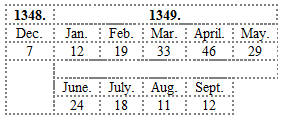
199
Reg. Edyndon, i, fol. 38.
200
R. O., Originalia Roll, 23 Ed. III., m. 37.
201
Pipe Roll, 23 Ed. III., m. 23.
202
R. O., L. T. R. Memoranda Roll, 28 Ed. III.
203
B. Mus. Cole MS., 5,824, p. 78 (from Reg. Lisle, fol. 24).
204
Rot. Pat. 27 Ed. III., pars. 1, m. 4.
205
At p. 92 of the printed edition of this chronicle the author describes the breaking out of the plague in France, just after the taking of Calais by the English. He attributes the truce between the French and the English to the epidemic.
206
Chronicon Galfridi Le Baker de Swynebroke, ed. E. M. Thompson, pp. 98–9.
207
R. O., Originalia Roll, 24 Ed. III., m. 8.
208
R. O., Rot. Claus., 25 Ed. III., m. 9.
209
R. O., Clerical Subsidy, 21/1 (51 Ed. III.)
210
The author seems to imply that the plague reached Ireland in 1348. It is, however, probable that 1349 was in reality the date, for in that year, on July 14, Alexander de Biknor, the Archbishop of Dublin, died, and also the Bishop of Meath in the same month (cf. Gams, Series Episcoporum, 219.)
211
Dalkey in the margin.
212
Friar John Clyn's Annals of Ireland (ed. Irish Archæological Society, 1849).
213
Rot. Pat., 25 Ed. III., pars 2, m. 19.
214
Ibid., 26 Ed. III., pars 1, m. 11.
215
R. O., L. T. R. Memoranda Roll, 27 Ed. III., Hilary term, m. 7.
216
The following is a table showing the Institutions in some months: —

217
Nash, Worcestershire, i, p. 226.
218
Green (Worcester, p. 144) speaks of the measures taken by the Bishop for the public safety as relieving the city "from an alarming evil," and by it the parishes of St. Alban, St. Helen, St. Swithun, St. Martin, St. Nicholas, and All Saints, "whose churchyards were very confined and not equal to the reception of the parochial deceased, were permitted to partake of the same advantages of sepulture… Hence St. Oswald's burial ground has accumulated that prodigious assemblage of tumulation which, at this time, cannot be viewed with indifference by the most cursory beholder."
219
Dated October 26th, 1352.
220
R. O., L. T. R. Memoranda Roll, 26 Ed. III.
221
Ibid., 28 Ed. III., Mich. term, m. 19.
222
The following table gives the number of Institutions in some months: —

223
Dugdale, Warwickshire, (ed. Thomas), p. 147.
224
Wood, History and Antiquities of the University of Oxford (ed. Gutch), p. 449.
225
Harl. MS., 1900, fol. 2. Trevisa's translation of FitzRalph's Propositio coram Papa: "So yt in my tyme, in ye University of Oxenford were thrilty thousand scolers at ones, and now beth unneth six thousand."
226
Gascoigne, Loci ex Libro Veritatum, ed. J. E. Thorold Rogers, p. 202. The editor on the passage says: "They (i. e. the students) come from all parts of Europe. The number seems incredible, but Oxfordshire was, to judge from its rating for exceptional taxation, after Norfolk, then at the best of its industries, the wealthiest county in England by a considerable proportion… This concourse of students was diverted by the great plague… I see no reason to doubt the statement about the exceeding populousness of Oxford in the first half of the 14th century."
227
R. O., L. T. R. Memoranda Roll, 23 Ed. III., Mich.
228
Six Centuries of Work and Wages, i, p. 223.
229
The Coming of the Friars, pp. 166–261.
230
The following is a table of the Institutions during four months: —

231
Ibid., p. 200.
232
Ibid., p. 203.
233
Blomefield, History of Norfolk (folio ed.), ii, p. 681.
234
F. Seebohm, The Black Death and its place in English History (in Fortnightly Review, Sept. 1st, 1865).
235
Fuller, Worthies, ed. Nicholas, ii, p. 132.
236
Ed. Nasmith, p. 344.
237
Professor Seebohm thinks that Yarmouth had probably a population of 10,000 before 1349. This seems much too low. It had 220 ships.
238
R. O., Rot. Claus., 26 Ed. III., m. 5d. This is repeated on two occasions in the next year.
239
B. Mus. Cole MS., 5,824, fol. 73. Extracts from Reg. Lisle.
240
Ibid., fol. 76.
241
The following table will give the number for some months: —

The total number of benefices in the diocese at this time was 142.
242
Cole MS., ubi supra.
243
Bentham, History of the Cathedral Church of Ely, i, p. 161, has the following note: Register L'Isle, fol. 17–21. Hinc obiter notandum duxi, numerum clericorum parochialium in tota Diocesi Elien. hoc tempore fuisse 145, aut circiter; ex hoc autem numero, constat ex Registro 92 Institutiones fuisse infra annum 1349 (anno incipiente 25 die Martii).
244
Clerical Subsidy, 21/1.
245
Six Centuries of Work and Wages, i, p. 223.
246
Hist. MSS. Comm., Sixth Report, p. 299. This document is dated 27th May, 1366, and consequently may refer also to the effects of the plague of 1361.
247
R. O., Duchy of Lancaster, Mins. Accts., Bundle 288, No. 471.
248
It was this church which some years later was declared to be in a ruinous state.
249
Cole MS., 5824, fol. 81.
250
R. O., Originalia Roll, 23 Ed. III., m. 6. Among the Ministers' Accounts (Q. R., Mins. Accts., General Series, 874, No. 9) is a set belonging to a Ramsey manor at this time. "Many holdings of natives" are said to be in hand "on account of the pestilence," and in one place "22 virgates of land" for the same reason.
251
R. O., Chancery Inq. p. m., 23 Ed. III., No. 88.
252
The following table will show the number of Institutions in Northamptonshire for some months; before May and after October, 1349, some 34 institutions are recorded: —

253
R. O., Rot. Pat., 28 Ed. III., pars 1, m. 16.
254
R. O., Chancery Inq. p. m., 23 Ed. III., No. 88.
255
Escheator's Inq. p. m., Series i, File 201.
256
Twysden, Historiæ Anglicanæ Scriptores Decem, col. 2699.
257
Rymer, Fœdera, v, p. 729.
258
R. O., Escheator's Inq. p. m., 23 Ed. III., Series i, file 240.
259
Originalia Roll, 25 Ed. III., m. 11.
260
The following table will give the number of Institutions in the diocese of Hereford for some months:

261
Reg. Trileck, fol. 103.
262
Owen and Blakeway, Shrewsbury, i, p. 165.
263
Ibid. The Inquisition is to be found in the Record Office; Chancery Inq. p. m., 23 Ed. III., No. 78.
264
Chancery Inq. p. m., 23 Ed. III., No. 79.
265
B. Mus. Harl. MS. 2071, ff. 159–160.
266
R. O. Clerical Subsidy, 51 Ed. III., 15/2.
267
R. O., Q. R. Mins. Accts., Bundle 801, No. 14.
268
Ibid., No. 4.
269
Notes on the Churches of Derbyshire. Introduction, p. viii.
270
R. O., Q. R. Mins. Accts., Bundle 801, file 3.
271
Seebohm, Black Death, in Fortnightly Review, Sept. 1, 1865, p. 150.
272
Vatican Archives, Reg. Pontif., Rubrice Litterarum Clem. VI.
273
Chronicon de Parco Lude (Lincoln Record Society), pp. 38–39.
274
R. O., Rot. Claus., 24 Ed. III., m. 7.
275
R. O., L. T. R. Memoranda Roll, 25 Ed. III.
276
Ibid., 28 Ed. III., Trinity term.
277
Raine, Historical Papers from Northern Registers (Rolls series), p. 395.
278
Ibid., p. 399.
279
Seebohm, Fortnightly Review, Sept. 1st, 1865.
280
Joseph Hunter, Deanery of Doncaster. The following table will give the institutions in this deanery for some months of 1349: —

281
B. Mus. Harl. MS., 6971, fol. 110b.
282
Raine, Historical Papers from Northern Registers, p. 491.
283
Chronicon Monasterii de Melsa (Rolls series), iii, 37.
284
Cf. for example Mins. Accts. Yorks., Holderness, 23–25 Ed. III., Bundle 355.
285
R. O., Chancery Inq. p. m., 23 Ed. III., 1st series, No. 72. Cf. also No. 88.
286
Rot. Pat., 28 Ed. III., pars 1, m. 3.
287
R. O., L. T. R. Memoranda Roll, 25 Ed. III.
288
Hunter, Deanery of Doncaster, i, p. 1. The Inquisitio post mortem of John FitzWilliam is in 1350.
289
Ibid., ii, p. 125.
290
Rot. Pat., 27 Ed. III., pars 1, m. 18.
291
R. O., Clerical Subsidy, 15/2.
292
R. O., Exchequer, Treasury of Receipt 21a/3, in English Historical Review, v, p. 525 (July, 1890).
293
Rot. Pat., 23 Ed. III., pars 3, m. 25.
294
e. g., Escheator's Inq. p. m., series i, 430.
295
R. O., L. T. R. Memoranda Roll, 28 Ed. III., m. 9.
296
R. O., Rot. Claus., 25 Ed. III., m. 16.
297
R. O., Durham Cursitor Records, Bk. ii, ff. 2b, seqq.
298
Rot. Claus., 27 Ed. III., m. 10d.
299
Rot. Claus., 24 Ed. III., pars 2, m. 5.
300
B. Mus. Cott. MS., Vitell., E. xiv, fol. 256.
301
Dr. Creighton (History of Epidemics in Britain, p. 119), speaking of Scotland, says: "The winter cold must have held it in check as regards the rest of Scotland; for it is clear from Fordoun that its great season in that country generally was the year 1350."
302
B. Mus. Cott. MS., Vitell., A. xx, fol. 56.
303
B. Mus. Harl. MS. 6979, f. 64.
304
Institutiones clericorum in Comitatu Wiltoniæ, ed. Sir J. Phillipps.
305
Originalia Roll, 23 Ed. III., m. 37.
306
Rot. Pat., 23 Ed. III., pars 1, m. 20.
307
R. O., Chancery Inq. p. m., 23 Ed. III. (1st numbers), No. 77.
308
Ibid., No. 78.
309
Ibid., No. 74.
310
Ibid., No. 87.
311
Escheator's Inq. p. m., Series i, File 95.
312
Ibid.
313
Records of the Manor of Gillingham, which I was permitted to examine by the kindness of the present Steward of the Manor, R. Freame, Esq., of Gillingham.
314
B. Mus. Add. Roll 24, 335.
315
B. Mus. Add. Rolls 15961–6. Perhaps the Richard Hammond capellanus who had a mill and six acres, and who is reported as among the dead, may have been the scribe.
316
Rot. Pat., 28 Ed. III., pars 1, m. 20 (16th January, 1354).
317
Rot. Pat., 29 Ed. III., pars 2, m. 4 (October 5th, 1355).
318
R. O., Escheator's Accts., 828/20.
319
R. O., Duchy of Lancaster Mins. Accts., No. 817.
320
Ibid.
321
R. O., L. T. R. Memoranda Roll, 28 Ed. III. (Trinity Term).
322
Judging by the ordination lists in the London Registers, the proportion of non-beneficed clergy was very large. In the twelve years, from 1362 to 1374, Bishop Sudbury ordained to the priesthood 456 regulars and 809 non-beneficed clergy, against 237 beneficed priests. According to this proportion, the non-beneficed would be six times as numerous as the beneficed.
323
R. O., Escheator's Inq. p. m., Series i., file 165. Also ibid., file 166. Esch. Accts., 838/23; 846/31. Cf. also, Exch. Q. R. Mins. Accts., Bundle 869, No. 9.
324
T. Cromwell, History of Colchester, i., p. 75.
325
R. O., Originalia Roll, 25 Ed. III., m. 10.
326
Escheator's Inq. p. m., Series i, File 165.
327
Rot. Pat., 25 Ed. III., Pars 3, m. 4.
328
B. Mus. Cole MS., 5824, fol. 86. Cf. Dr. Cunningham, Growth of English Industry and Commerce, p. 305.
329
R. O., L. T. R. Memoranda Roll, 27 Ed. III. (Hilary term), m. 7.
330
Rot. Claus., 26 Ed. III., m. 7.
331
Hist. MSS. Comm., Fifth Report, p. 444. These lands were apparently the Appledore Marshes, which subsequently cost the monastery £350 to reclaim.
332
Sussex Archæological Society, Vol. xxi, pp. 44, seqq.
333
Reg. Pontissera, fol. 143.
334
This may be considered the number in the previous century from the Annales de Wintonia.
335
Reg. Wykeham, ii, fol. 226.
336
The following are the number of monks belonging to Winchester Cathedral Priory at the annexed dates: —
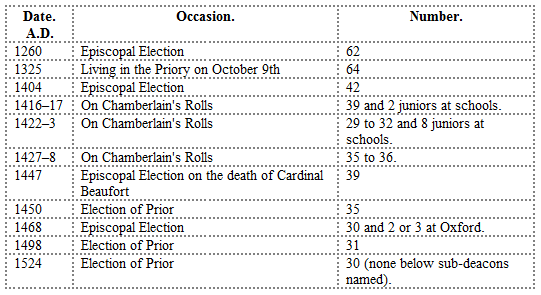
337
Harl. MS., 1761, f. 20.
338
Rot. Claus., 28 Ed. III., m. 3d (dated February 6th, 1353).
339
Ibid., m. 6 (July 8th).
340
Rot. Pat., 23 Ed. III., pars 1a, m. 13.
341
Reg. Edyndon, ii, ff. 27b, 28.
342
Ibid., fol. 28.
343
Reg. Edyndon, i, fol. 49b.
344
Ibid., ii, fol. 23b.
345
Ibid., fol. 22b.
346
Ibid., fol. 23b.
347
Rot. Claus., 27 Ed. III., m. 19.
348
Rot. Claus., 26 Ed. III., m. 12.
349
Ibid., 25 Ed. III., m. 21.
350
Originalia Roll, 29 Ed. III., m. 8.
351
Rot. Claus., 26 Ed. III., m. 19. Cf. Patent Roll, 26 Ed. III., pars 1, m. 6.
352
Rot. Pat., 26 Ed. III., pars 1a, m. 28d.
353
Escheator's Inq. p. m., series i, file 90.
354
Escheator's Inq. p. m., 22–23 Ed. III., series i, file 64.
355
Rot. Pat., 27 Ed. III., m. 17.
356
Ed. Bristol and Gloucester Archæological Society, i, 307.
357
Reg. Heref. Trileck., fol. 102.
358
Bruton Chartulary f. 121b. Prior Henry appears to have spent the money thus raised in the expenses of a journey to Rome and Venice and back. The inquiry was held in June, 29 Ed. III.
359
Escheator's Inq. p. m., Series i, file 240.
360
Escheator's Inq. p. m., Series i, file 103.
361
Rot. Pat., 25 Ed. III., pars 1a, m. 16.
362
Ibid., 28 Ed. III., m. 10.
363
Ibid., m. 3.
364
Quoted in Saturday Review, Jan. 16, 1886, "The Manor."
365
R. O., L. T. R. Memoranda Roll, 25 Ed. III.
366
Cf. T. Amyot, Population of English Cities, temp. Ed. III. (Archæologia, Vol. xx, pp. 524–531).
367
England before and after the Black Death (Fortnightly Review, Vol. viii, p. 191).
368
W. Cunningham, Growth of English Industry and Commerce, p. 304.
369
Fortnightly Review, viii, p. 192. This is, of course, true, but without qualification might give the reader a false impression as to the condition of the English peasant in the middle ages. Most of what Mr. Thorold Rogers says is applicable to all classes of society. Dr. Cunningham (Growth of English Industry and Commerce, p. 275) takes a truer view: "Life is more than meat, and though badly housed the ordinary villager was better fed and amused."
370
B. Mus. Cott. MS., Faust, B. v, fol. 99b.
371
R. O., Originalia Roll, 26 Ed. III., m. 27.
372
Ibid., 27 Ed. III., m. 19.
373
Ibid., 26 Ed. III., m. 25.
374
Ed. Twysden, col. 2699.
375
B. Mus. Cott. MS., Faust, B. v, fol. 98b.
376
R. O., Q. R. Mins. Accts., Bundle 801, No. 1.
377
Introduction, p. ix.
378
Of course, several of these would be ordained for other dioceses, but in the same way Winchester priests would be ordained by letters dimissory elsewhere, so that taking the whole of England we may assume a practical equalisation. In the diocese of London, as already stated (p. 175 ante), the proportion of non-beneficed to beneficed clergy ordained during 12 years, from 1362 to 1374, was nearly six to one.
379
Pope, Essay on Man, lines 107–8.
380
Mr. Thorold Rogers' supposition that the population in 1348 was only about 2,500,000 would, on the assumption that the two sexes were about equal in number, lead to the conclusion that one man in every 25 was a priest; a suggestion which seems to bear, on the face of it, its own refutation.
381
Amyot (Archæologia, xx, p. 531) notes that even soldiers appear to have been better paid than the clergy. A foot soldier had 3d. a day, or 7 marks a year; a horse soldier 10d. or 12d. a day. Chaucer's good parson, who was only "rich of holy thought and werk," might not be remarkable.
382
Ed. Twysden, col. 2699.
383
Mr. Baigent's MS. extracts from the Episcopal Registers. It is of interest to note that in normal times very few were ordained after their appointment as incumbents. Thus, to take the churches in the city of Winchester, besides this period and 1361, when again the mortality among the clergy was very great, only some 8 or 9 were so ordained between 1349 and 1361, as the following table will show: —


